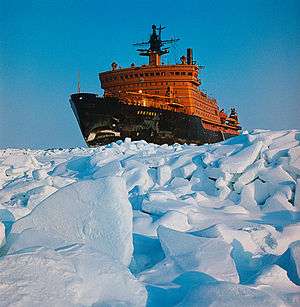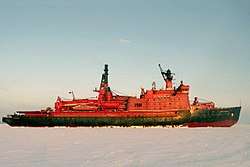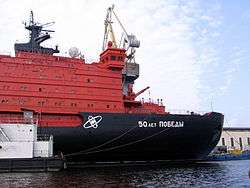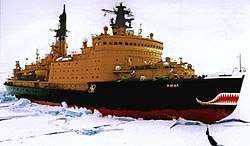Arktika-class icebreaker
The Arktika class is a Russian (former Soviet) class of nuclear-powered icebreakers. Formerly known as Project 10520 nuclear-powered icebreaker, they were the world's largest and most powerful icebreakers until the 2016 launch of the first Project 22220 icebreaker, also named Arktika.[3][4] Ships of the Arktika class are owned by the federal government, but were operated by the Murmansk Shipping Company (MSCO) until 2008, when they were transferred to the fully government-owned operator Atomflot. Of the ten civilian nuclear-powered vessels built by Russia (and the Soviet Union), six have been of this type. They are used for escorting merchant ships in the Arctic Ocean north of Siberia as well as for scientific and recreational expeditions to the Arctic.
 Arktika | |
| Class overview | |
|---|---|
| Builders: | Baltic Shipyard |
| Operators: | FSUE Atomflot |
| Succeeded by: | Project 22220 icebreaker |
| Built: | 1971–2007 |
| In service: | 1975–present |
| Completed: | 6 |
| Active: | 2 |
| Retired: | 4 |
| General characteristics [1][2] | |
| Type: | Icebreaker |
| Tonnage: | 18,172 GRT |
| Displacement: | 23,000–25,168 tons |
| Length: | 148 m (486 ft) |
| Beam: | 30 m (98 ft) |
| Height: | 17.2 m (56 ft) |
| Draught: | 11 m (36 ft) |
| Installed power: | Two OK-900A nuclear reactors (2 × 171 MW)Two steam turbogenerators (2 × 27.6 MW) |
| Propulsion: | Nuclear-turbo-electricThree shafts (3 × 18 MW) |
| Speed: | 20.6 knots (38.2 km/h; 23.7 mph) (maximum) |
| Endurance: | 7.5 months |
| Crew: | 189 |
| Aircraft carried: | 1 × Mi-2, Mi-8 or Ka-27 helicopter |
| Aviation facilities: | Helipad and hangar for one helicopter |
History
On July 3, 1971, construction began on a conceptual design of a larger nuclear icebreaker, dubbed Arktika, in the Baltic Shipyard in then Leningrad.[5] Four years later, on December 17, 1975, Moscow and Leningrad received radio messages informing them that sea trials had been completed successfully. The newest and largest nuclear icebreaker at the time was ready for the Arctic.[6]
Arktika was the first surface ship to reach the North Pole, on August 17, 1977.
As the leading vessel in Russia’s second nuclear icebreaker class, Arktika became the classification name for five icebreakers to follow: the Sibir in 1977, Rossiya in 1985, Sovetskiy Soyuz in 1989, the Yamal in 1992[7] and the 50 Let Pobedy in 2007.
The first of new class of nuclear icebreakers, the LK-60Ya class, was launched in 2016. Also called Arktika, it was launched in anticipation of decreasing ice and increased traffic.[8]
Design and construction
The Arktika is a double-hulled icebreaker; the outer hull is 48 mm (1.89 in) thick, the inner 25 mm (0.98 in) thick, with the space in between utilized for water ballasting. At the strongest point, the cast steel prow is 50 cm (19 ¾ in) thick and bow-shaped to aid in icebreaking, the curve applying greater dynamic force to fracture the ice than a straight bow would. The maximum ice thickness it can break through is approximately 5 meters (16.4 ft). Like many icebreakers, Arktika also has an air bubbling system (ABS) which delivers 24 m3/s of steam from jets 9 m (29.5 ft) below the surface to further aid in the breakup of ice.[6]
The ship is divided by eight bulkheads, providing nine watertight compartments in the event of disaster, and can undergo short towing operations when needed. It also comes equipped with a helicopter pad and hangar at the aft of the ship.[6] Mil Mi-2 "Hoplite", dubbed ptichka (Russian for "little bird"), or Kamov Ka-27 "Helix" helicopters are used for scouting expeditions to find safe routes through the ice floes.[9]
OK-900A reactors
Over the period December 1967 to May 1970, Lenin, precursor of the Arktika and the first nuclear-propelled icebreaker, had its three OK-150 reactors, capable of 90 MW each, replaced with two OK-900 reactors, capable of 159 MW each.[5] The work was carried out at the Zvezdochka yard in Severodvinsk.[10]
Arktika and the entire Arktika-class icebreaker fleet are outfitted with two OK-900A reactors, which deliver 171 MW each. Each reactor is contained in its own closed compartment and weighs 160 tonnes. They are shielded by water, steel, and high density concrete, and ambient radiation is monitored throughout the ship by 86 sensors.[6] The reactors were originally fueled by a 90% enriched, zirconium-clad, uranium fuel. Those reactors still in operation today now use a 20%-90% enriched with 60% average enrichment uranium dispersed in an aluminum matrix.[11] The chain reaction can be stopped in 0.6 seconds by the full insertion of safety rods.[6]
Arktika consumes up to 200 grams of fuel a day when breaking ice. There are 500 kg of uranium isotopes in each reactor, allowing for at least 13.7 years between changing reactor cores. The used cores are extracted and replaced in Murmansk, the spent fuel reprocessed and waste disposed of at a radioactive waste plant.[6]
Propulsion
Both the OK-150 and OK-900(A) are pressurized water reactors, meaning that cooling water is continually pumped under pressure through the reactor to remove heat, keeping the cores and the reactor cool. The heated water is pumped from the reactor to a boiler (four boilers per reactor), where it transfers its heat into another body of water, producing steam at a rate of 30 kg/cm3 (approx 1,084 psi) . Each set of four boilers drives two steam turbines, which turn three dynamos. One kilovolt of direct current is then delivered to three double-wound motors directly connected to the propeller, providing an average screw velocity of 120-180 rpm. Five auxiliary steam turbines are tied into the plant to provide electricity, turning dynamos which develop 30 MW.[6]
Three fixed-pitch propellers provide Arktika with its thrust, power, and maneuverability. The starboard and centerline propellers turn clockwise while the port turns counter clockwise to compensate. Each propeller sits at the end of a 20 meter (65.6 ft) shaft and has four blades, which weigh seven tons and are attached by nine bolts to the hub which is 5.7 meters (18.7 ft) in diameter and weighs 50 tonnes. Arktika also carries four spare blades along with the appropriate diving equipment and tools so that propeller repairs may be made at sea; the operation can take anywhere from one to four days depending on the extent of the damage.[6]
The propellers can deliver a combined bollard pull of 480 tons with 18-43 MW (25,000 shaft horsepower) [totals: 55.3 MW (75,000 shp)]. This amounts to a maximum speed of 22 knots (41 km/h; 25 mph) on open water, full speed of 19 knots (35 km/h; 22 mph), and an average speed of 3 knots (5.6 km/h; 3.5 mph) while icebreaking 2–3 metres (7–10 ft) thick level ice.[6]
Ships
| Name | Builder | Laid down | Launched | Commissioned | Status |
|---|---|---|---|---|---|
| Arktika | Baltic Shipyard | 3 July 1971 | 26 December 1972 | 25 April 1975 | Decommissioned in 2008, moored in Murmansk |
| Sibir | Baltic Shipyard | 26 June 1974 | 23 February 1976 | 28 December 1977 | Decommissioned in 1992, moored in Murmansk |
| Rossiya | Baltic Shipyard | 20 February 1981 | 2 November 1983 | 20 December 1985 | Decommissioned in 2013, laid up in Murmansk |
| Sovetskiy Soyuz | Baltic Shipyard | 2 November 1983 | 31 October 1986 | 29 December 1989 | Decommissioned in 2014, laid up |
| Yamal | Baltic Shipyard | 1986 | 1989 | October 1992 | In service |
| 50 Let Pobedy | Baltic Shipyard | 4 October 1989 | 29 December 1993 | 23 March 2007 | In service |
References
- "Atomic Icebreaker Characteristics". rosatomflot.ru. Retrieved 9 October 2017.
- "Atomic Icebreakers Technical Data". rosatomflot.ru. Retrieved 9 October 2017.
- "Атомоход "50 лет Победы" готовится к выходу в Балтику". RIA Novosti. 18 January 2012.
- https://www.npr.org/sections/thetwo-way/2016/06/16/482288188/russia-launches-worlds-biggest-most-powerful-icebreaker
- Olagaard, P. Reistad, O. (April 2006). Russian Nuclear Power Plants for Marine Applications
- Pike, J. Project 10520 Arktika/ Global Security.Org. http://www.globalsecurity.org/military/world/russia/10520.htm
- Hore-Lacy, I. World Nuclear Agency. (January 11, 2010). Nuclear Powered Ships/Encyclopedia of Earth.Org. "Archived copy". Archived from the original on 2012-10-20. Retrieved 2012-04-19.CS1 maint: archived copy as title (link)
- "Russia Launches World's Biggest, Most Powerful Icebreaker". NPR.org. 16 June 2016. Retrieved 21 June 2016.
- Walston, O. (1994), Arktika. London: Reed Consumer Ltd.
- "Nuclear icebreaker Lenin" Archived October 15, 2007, at the Wayback Machine, Bellona, 20/06/2003.
- Bukharin, O. (2006), Russia’s Nuclear Icebreaker Fleet. Taylor and Francis Group, LLC.
External links
- Nuclear Powered Icebreakers, Bellona Foundation
- Technical information, MSCO
- Russia scraps another nuclear-powered icebreaker, Barents Observer,
- The Yamal, a nuclear powered Icebreaker page, Cool Anatartica


